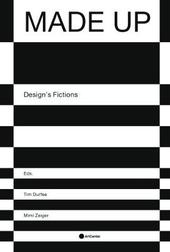
|
Made Up: Design's Fictions
Paperback / softback
Main Details
| Title |
Made Up: Design's Fictions
|
| Authors and Contributors |
Edited by Tim Durfee
|
|
Edited by Mimi Zeiger
|
| Physical Properties |
| Format:Paperback / softback | | Pages:108 | | Dimensions(mm): Height 235,Width 160 |
|
| Category/Genre | Architecture |
|---|
| ISBN/Barcode |
9781532347887
|
| Classifications | Dewey:745.4 |
|---|
| Audience | | Postgraduate, Research & Scholarly | |
|---|
| Edition |
English ed.
|
|
Publishing Details |
| Publisher |
Actar Publishers
|
| Imprint |
Actar Publishers
|
| Publication Date |
15 October 2018 |
| Publication Country |
United States
|
Description
Through essays, interviews, and narratives by Bruce Sterling, Fiona Raby, Sam Jacob and other significant voices in the field, this volume questions the initial discourses around "design fiction"-a broad category of critical design that includes overlapping interests in science fiction, world building, speculation, and futuring. Made Up: Design's Fictions advances contemporary analysis and enactment of narrative and speculation as an important part of practice today. Essays, interviews, and narratives by: Julian Bleecker, Benjamin H. Bratton, Anne Burdick, Emmet Byrne, Stuart Candy, Fiona Raby, Tim Durfee, Sam Jacob, Norman M. Klein, Peter Lunenfeld, Geo Manaugh, Tom Marble, m-a-u-s-e-r, Metahaven, China Mieville, Keith Mitnick, MOS, Susanna Schouweiler, Bruce Sterling, Mimi Zeiger. Co-published with Art Center Graduate Press
Author Biography
Tim Diurfee heads Tim Durfee Studio in Los Angeles. After earning his architecture degree from Yale, Durfee moved to LA to teach architectural design and direct the Visual Studies program at the Southern California Institute of Architecture. Eventually, he reoriented his work toward an expanded interdisciplinary practice at the intersection of architecture, art, and media. Since 2010, Durfee has been professor at ArtCenter College of Design's Media Design Practices program, a department focusing on emerging roles and contexts for design and technology. Tim Durfee's independent and collaborative work has won awards and distinctions from the AIA, AIGA, Print, Build, and Architizer. In 2015, Tim was chosen to be included as one of Fifty Under Fifty: Innovators of the 21st Century, by jury Stanley Tigerman, Jeanne Gang, Qingyun Ma, and Marion Weiss. Mimi Zieger is a Los Angeles-based critic, editor, and curator. Her work is situated at the intersection architecture and media cultures. She has covered art, architecture, urbanism, and design for a number of publications including The New York Times, Domus, Architectural Review, and Architect, where she is a contributing editor. She is a regular opinion columnist for Dezeen and former West Coast Editor of The Architects Newspaper. Zeiger is the 2015 recipient of the Bradford Williams Medal for excellence in writing about landscape architecture. Zeiger is author of New Museums, Tiny Houses and Micro Green: Tiny Houses in Nature, and Tiny Houses in the City. In 1997, Zeiger founded loud paper, an influential zine and digital publication dedicated to increasing the volume of architectural discourse. She has curated, contributed to, and collaborated on projects that have been shown at the Art Institute Chicago, 2012 Venice Architecture Biennale, the New Museum, Storefront for Art and Architecture, pinkcomma gallery, and the AA School. She co-curated Now, There: Scenes from the Post-Geographic City, which received the Bronze Dragon award at the 2015 Bi-City Biennale of Urbanism \ Architecture, Shenzhen.
Reviews"We don't think much about public seating: We spy an empty bench in a park or a vacant chair in a town square and we deposit ourselves on its accommodating surface. Renowned landscape architect Laurie Olin, however, has spent a lifetime reflecting on how and where we sit, especially outside. The delightful volume "Be Seated" (Applied Research + Design, 213 pages, $34.95) contains his ruminations on the nature and design of public places for hanging out, the ideas behind his commissions for such spaces as Bryant Park and Columbus Circle in New York City, and a brief history of public seating (until the emergence of the Piazza Signoria in Florence in the 1400s, people mostly plunked themselves on the ground). The book is generously supplemented with Mr. Olin's charming sketches and disarming observations: "An individual approaching a chair will often move it slightly, even if barely an inch or two, as an act of taking possession before sitting on it."" --The Wall Street Journal
|